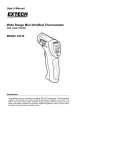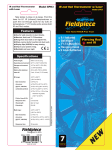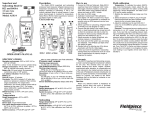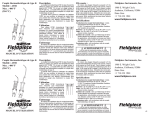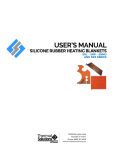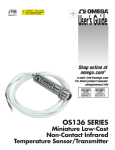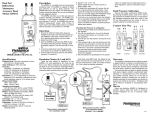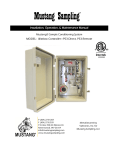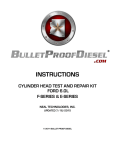Download Opman SSX34 v14.qxd - Fieldpiece Instruments
Transcript
Description Fieldpiece Superheat and Subcooling Meter For A/C and Refrigeration with Pipe Clamp Model: SSX34 K SH SC TYPE ATM T2 TEMP. UNIT T2 AUTO-OFF BATTERY CHECK ON/OFF PRESS FOR 1 SECOND Temp Cal The SSX34 is a portable standalone superheat and subcooling meter for A/C and refrigeration. The SSX34 is designed to fit the needs of the HVACR technician with a rugged rubber boot for durability and magnetic hanger for easy use. Hang the magnetic hanger over a corner to minimize slip. Plug in the pipe clamp thermocouple into the K-Type thermocouple plug. You can connect the SSX34 directly to the A/C or refrigeration system using a standard 1/4” EPA approved refrigerant hose using the pressure port at the top of the meter. You can even use the “T” included to charge the unit while checking superheat or subcooling, making it possible to charge to superheat or subcooling. The SSX34 will display superheat or subcooling for R-22, R-410A, R-134A and R-404A. The pipe clamp will take the temperature reading of the refrigerant piping giving the actual refrigerant temperature. The refrigerant hose will then sense the refrigerant pressure. The SSX34 then uses the actual temperature and boiling point (at the sensed pressure) to calculate and display real-time actual subcooling or superheat as well as display refrigerant temperature and pressure. Operation OPERATOR’S MANUAL General Operating environment: 32ºF (0°C) to 122ºF (50°C) <75% RH Storage environment: -4ºF (-20°C) to 140ºF (60°F) <80% RH with battery removed from meter. Overrange: “OL” or “-OL” is displayed. Auto-off power: 15 minutes Temperature coefficient: 0.05 x (specified accuracy) per °C Accuracy: Stated accuracy at 23°C ± 5° (73°F ± 9°F), <90%R.H. Battery: Single standard 9-volt battery, NEDA 1604, JIS 006P, IEC 6F22. Low battery: symbol is displayed. Temperature Temperature Input: Standard K-type thermocouple connectors Measurement range: -40 to 400ºF(-40 to 204°C) (180°F/82°C max with supplied ATC1 pipe clamp thermocouple) Resolution: 0.1º System accuracy after field calibration: ±1.0ºF @ -40 to 200ºF with field calibration ±0.5ºC @ -40 to 93ºC with field calibration ±2.0ºF @ 200 to 400ºF with field calibration ±1.0ºC @ 93 to 204ºC with field calibration 1. Connect the thermocouple pipe clamp and refrigerant hose to the meter. 2. Calibrate if needed (see Field calibration). 3. Select °C or °F by holding down the °C or °F Pressure Pressure Input: Standard 1/4” male flare fitting Measurement range: 29” HgV to 500PSIG (english) 74 cmHgV to 0 to 4000KPa (metric) HgV indicates a vacuum measurement in either inches (english) or cm (metric) of mercury. A perfect vacuum would be 29.92”HgV or 76.00cmHgV. Atmospheric pressure at sea level would be 0” HgV and 0 cmHgV. System accuracy after field calibration: 29” HgV to 0” HgV: ±0.2” HgV 74 cmHgV to 0 cmHgV: ±0.4 cmHgV 0 to 200 Psi: ±1 Psi 0 to 1378 KPa: ±7 KPa 200 to 500 Psi: ±0.3%+1 Psi 1378 to 3447KPa: ±0.3%+7 KPa Maximum overload pressure: 800PSIG ! WARNINGS ! Never take pressure readings exceeding 500Psi (3500kPa) or serious injury or damage to the meter may occur. button while turning on the SSX34. 4. Hand tighten 1/4” flare to suction line or liquid line as close to the evaporator or condenser as possible using an EPA approved service hose (not included). 5. Select proper pressure units (english psi or metric KPa) by pressing the UNIT button. 6. Select refrigerant (R22, R410A, R134A, or R404A) by pressing the TYPE button and observing the arrow at the bottom of the LCD. 7. Connect the pipe clamp to the suction (superheat) or liquid (subcooling) line at least six inches from the compressor and slide it under the insulation for best accuracy isolating the pipe clamp from the ambient air. 8. Select temperature to display (superheat, subcooling, or refrigerant temperature). Temperature being displayed is designated by the arrows along the right side of the LCD “K” is the direct temperature from the thermocouple (actual refrigerant temperature). “SH” is superheat and “SC” is subcooling. Pressure is constantly displayed in lower right. 9. You must wait until the system you are testing has stabilized. 10. Once you have the superheat or subcooling reading follow the manufacturer of the air conditioner’s specifications to properly charge or diagnose the system. Temperature: To calibrate the SSX34 temperature, adjust the pot on the front of the meter labeled “Temp-Cal”. The best way to calibrate is to match to a known temperature. Ice water is very close to 32ºF and is readily available. Accuracies of one degree or better are easily obtained. 1. Stabilize a large cup of ice water. Pure, distilled water will be the most accurate. 2. Using the Type button, scroll through temperature displayed until you reach the “K” spot, which is the direct temperature input from the Ktype thermocouple. 3. Immerse the temp probe in ice water and let it stabilize. Pressure: To calibrate the SSX34 pressure, ensure that the SSX34 is disconnected from the pressure source and at equilibrium with the ambient pressure. Press the ATM button and the SSX34 will set the “zero” point of pressure to the ambient pressure. Battery Check Function Service Field Calibration The SSX34 allows the user to check the battery charge at any time during use, simpily by holding down the UNIT button for over one second. The approximate percentage of battery charge will be displayed on the main display for three seconds before returning to its reading prior to preforming the battery check. Unit Fluctuations Near Zero When the pressure/vacuum is near zero, the unit shown on the display may fluctuate between vacuum and pressure. This is similar to a classical gauge face as shown. Below zero is vacuum (inHg or cmHG), above 0 is pressure (psi or kPa). There is nothing wrong if this happens. The appropriate units will be displayed when a pressure/vacuum measurement is taken. Return any defective SSX34 to Fieldpiece for warranty service along with proof of purchase. Contact Fieldpiece for out of warranty repair charges. Warranty The product is warranted to the original purchaser against defects in material or workmanship for a period of one (1) year from the date of purchase. During the warranty period, Fieldpiece Instruments will, at its option, replace or repair the defective unit. This warranty does not apply to defects resulting from abuse, neglect, accident, unauthorized repair, alteration, or unreasonable use of the instrument. Any implied warranty arising out of the sale of Fieldpiece's products including but not limited to implied warranties of merchantability, and fitness for purpose, are limited to the above. Fieldpiece shall not be liable for incidental or consequential damages. Checking Throttle Valve (TXV, Cap. Tube, Fixed Orifice) Subcooling Using the SSX34 K SH SC Liquid BATTERY CHECK Condenser ow Fl Liquid & Vapor Fl UNIT T2 AUTO-OFF frig e ra nt TEMP. Re ATM T2 frig e ra nt TYPE Re Superheat is the difference between the actual temperature of the refrigerant (gas) as it leaves the evaporator and the boiling point temperature of the refrigerant in the evaporator coil. After boiling, the refrigerant continues to warm up. The number of degrees it “warmed up” after boiling is called the superheat. Under worst case conditions (low load for fixed orifice systems), the refrigerant in the evaporator boils off near the end of the evaporator coil. To make sure liquid doesn’t enter the compressor under the worst case condition (low load), the refrigerator manufacturers publish charts indicating what the superheat should be at a given indoor wet bulb measurement and outdoor air temperature. Measuring superheat is your best indication on a fixed orifice system of the proper refrigerant charge and operating conditions. If everything else is working properly and the actual superheat is too high, add refrigerant. If it’s too low, remove refrigerant. Subcooling is the difference between the boiling point of the refrigerant in the condenser and the actual temperature of the refrigerant as it leaves the condenser. The degrees that the refrigerant “cools down” below the boiling point is the subcooling. Under worst case scenario (low load for TXV) the subcooling will continue to rise. If the subcooling rises to high, liquid may be backed into the compressor causing damage and catastrophic failure. On TXV systems, subcooling is the best indication of the state of charge in the refrigerant system since these systems are designed to maintain constant superheat. Properly charging a system ensures maximum efficiency and longer equipment life. The hose must have a schraeder valve depresser on one end to release the refrigerant from the suction or liquid line. This is the same type of hose available with most pressure gauge sets. We suggest EPA sanctioned “no leak” hoses. Exercise caution whenever working with any electricity and high pressure liquid or gas. Follow all instructions provided with equipment being serviced or installed. ow Measuring Actual Superheat and Subcooling Liquid Liquid & Vapor Evaporator ON/OFF PRESS FOR 1 SECOND Target Superheat and Subcooling Temp Cal Vapor Heed all equipment manufacturer’s specifications, warnings and suggestions above anything found in this manual. To determine the target superheat (fixed orifice system) or subcooling (charts vary dramatically from one system to another), you need the manufacturers target superheat chart or subcooling chart. You can use the ARH4 Fieldpiece accessory head for both wet bulb, dew point and dry bulb measurements. Generic Target Superheat Charts* Vapor K SH SC Compressor TYPE ATM T2 TEMP. UNIT T2 T2 AUTO-OFF Checking Superheat Using the SSX34 BATTERY CHECK ON/OFF PRESS FOR 1 SECOND Temp Cal * These charts are an example of a generic superheat charts for a typical fixed orifice, split residential system. These charts should not be used for charging. A typical manufacturer’s recommended subcooling is 12°F (7°C). These are only examples of what the manufacturer’s may recommend. Heed all manufacturer’s indications, instructions and warnings above those in this manual. The indoor wet bulb measurement can be accomplished by a Fieldpiece ARH4 or ATWB1 and should be taken as close to the evaporator coil inlet as possible. The outdoor dry bulb reading can be taken with an ARH4, ATB1, ATA1 or any other Fieldpiece air thermocouple and should be taken as close to the condenser air inlet as possible. v14



